






































































































Preview text:
Assignment Problems Paul Dawkins
Calculus II – Assignment Problem s i Ta T b a l b e l o f o C o C n o te t n e t n s t
Preface ................................................................................................................................................................. iii
Outline.................................................................................................................................................................. iv
Chapter 1 : Integration Techniques ........................................................................................................................ 1
Section 1-1 : Integration by Parts .............................................................................................................................. 3
Section 1-2 : Integrals Involving Trig Functions ......................................................................................................... 5
Section 1-3 : Trig Substitutions.................................................................................................................................. 7
Section 1-4 : Partial Fractions .................................................................................................................................. 10
Section 1-5 : Integrals Involving Roots .................................................................................................................... 12
Section 1-6 : Integrals Involving Quadratics ............................................................................................................ 13
Section 1-7 : Integration Strategy ........................................................................................................................... 14
Section 1-8 : Improper Integrals .............................................................................................................................. 15
Section 1-9 : Comparison Test for Improper Integrals ............................................................................................ 17
Section 1-10 : Approximating Definite Integrals ..................................................................................................... 18
Chapter 2 : Applications of Integrals .................................................................................................................... 19
Section 2-1 : Arc Length .......................................................................................................................................... 20
Section 2-2 : Surface Area ....................................................................................................................................... 22
Section 2-3 : Center of Mass ................................................................................................................................... 24
Section 2-4 : Hydrostatic Pressure and Force ......................................................................................................... 25
Section 2-5 : Probability .......................................................................................................................................... 28
Chapter 3 : Parametric Equations and Polar Coordinates ..................................................................................... 30
Section 3-1 : Parametric Equations and Curves ...................................................................................................... 32
Section 3-2 : Tangents with Parametric Equations ................................................................................................. 35
Section 3-3 : Area with Parametric Equations ......................................................................................................... 36
Section 3-4 : Arc Length with Parametric Equations ............................................................................................... 37
Section 3-5 : Surface Area with Parametric Equations ............................................................................................ 38
Section 3-6 : Polar Coordinates ............................................................................................................................... 39
Section 3-7 : Tangents with Polar Coordinates ....................................................................................................... 41
Section 3-8 : Area with Polar Coordinates .............................................................................................................. 42
Section 3-9 : Arc Length with Polar Coordinates ..................................................................................................... 43
Section 3-10 : Surface Area with Polar Coordinates ............................................................................................... 44
Section 3-11 : Arc Length and Surface Area Revisited ............................................................................................ 45
Chapter 4 : Series & Sequences ............................................................................................................................ 46
Section 4-1 : Sequences .......................................................................................................................................... 49
Section 4-2 : More on Sequences ............................................................................................................................ 50
Section 4-3 : Series - The Basic
s .............................................................................................................................. 51
Section 4-4 : Convergence/Divergence of Series .................................................................................................... 52
Section 4-5 : Special Series ...................................................................................................................................... 54
Section 4-6 : Integral Test........................................................................................................................................ 55
Section 4-7 : Comparison Test/Limit Comparison Test ........................................................................................... 56
Section 4-8 : Alternating Series Test ....................................................................................................................... 57
Section 4-9 : Absolute Convergence ....................................................................................................................... 58
Section 4-10 : Ratio Test .......................................................................................................................................... 59
Section 4-11 : Root Test .......................................................................................................................................... 60
Section 4-12 : Strategy for Series ............................................................................................................................ 61 © 2018 Paul Dawkins
http://tutorial.math.lamar.edu
Calculus II – Assignment Problem s ii
Section 4-13 : Estimating the Value of a Series ....................................................................................................... 62
Section 4-14 : Power Series ..................................................................................................................................... 63
Section 4-15 : Power Series and Functions ............................................................................................................. 64
Section 4-16 : Taylor Series ..................................................................................................................................... 65
Section 4-17 : Applications of Series ....................................................................................................................... 66
Section 4-18 : Binomial Series ................................................................................................................................. 67
Chapter 5 : Vectors .............................................................................................................................................. 68
Section 5-1 : Vectors - The Basics ............................................................................................................................ 69
Section 5-2 : Vector Arithmetic ............................................................................................................................... 70
Section 5-3 : Dot Product ........................................................................................................................................ 72
Section 5-4 : Cross Product ..................................................................................................................................... 74
Chapter 6 : 3-Dimensional Space ......................................................................................................................... 75
Section 6-1 : The 3-D Coordinate System ................................................................................................................ 77
Section 6-2 : Equations of Lines .............................................................................................................................. 78
Section 6-3 : Equations of Planes ............................................................................................................................ 80
Section 6-4 : Quadric Surfaces ................................................................................................................................ 82
Section 6-5 : Functions of Several Variables ........................................................................................................... 83
Section 6-6 : Vector Functions ................................................................................................................................ 84
Section 6-7 : Calculus with Vector Functions .......................................................................................................... 86
Section 6-8 : Tangent, Normal and Binormal Vectors ............................................................................................. 88
Section 6-9 : Arc Length with Vector Functions ...................................................................................................... 89
Section 6-10 : Curvature .......................................................................................................................................... 90
Section 6-11 : Velocity and Acceleration ................................................................................................................. 91
Section 6-12 : Cylindrical Coordinates..................................................................................................................... 92
Section 6-13 : Spherical Coordinates ...................................................................................................................... 93 © 2018 Paul Dawkins
http://tutorial.math.lamar.edu
Calculus II – Assignment Problems ii i Pr P e r f e a f c a e
Here are a set of assignment problems for the Calculus II notes. Please note that these problems
do not have any solutions available. These are intended mostly for instructors who might want a
set of problems to assign for turning in. Having solutions available (or even just final answers)
would defeat the purpose the problems.
If you are looking for some practice problems (with solutions available) please check out the
Practice Problems. There you will find a set of problems that should give you quite a bit practice. © 2018 Paul Dawkins
http://tutorial.math.lamar.edu Calculus II iv Ou O t u l t iln i e n
Here is a listing of sections for which assignment problems have been written as well as a brief
description of the material covered in the notes for that particular section.
Integration Techniques – In this chapter we will look at several integration techniques including
Integration by Parts, Integrals Involving Trig Functions, Trig Substitutions and Partial Fractions. We will
also look at Improper Integrals including using the Comparison Test for convergence/divergence of improper integrals.
Integration by Parts – In this section we will be looking at Integration by Parts. Of all the
techniques we’ll be looking at in this class this is the technique that students are most likely to
run into down the road in other classes. We also give a derivation of the integration by parts formula.
Integrals Involving Trig Functions – In this section we look at integrals that involve trig
functions. In particular we concentrate integrating products of sines and cosines as well as
products of secants and tangents. We will also briefly look at how to modify the work for
products of these trig functions for some quotients of trig functions.
Trig Substitutions – In this section we will look at integrals (both indefinite and definite) that
require the use of a substitutions involving trig functions and how they can be used to simplify certain integrals.
Partial Fractions – In this section we will use partial fractions to rewrite integrands into a form
that will allow us to do integrals involving some rational functions.
Integrals Involving Roots – In this section we will take a look at a substitution that can, on
occasion, be used with integrals involving roots.
Integrals Involving Quadratics – In this section we are going to look at some integrals that
involve quadratics for which the previous techniques won’t work right away. In some cases,
manipulation of the quadratic needs to be done before we can do the integral. We will see
several cases where this is needed in this section.
Integration Strategy – In this section we give a general set of guidelines for determining how to
evaluate an integral. The guidelines give here involve a mix of both Calculus I and Calculus II
techniques to be as general as possible. Also note that there really isn’t one set of guidelines
that will always work and so you always need to be flexible in following this set of guidelines.
Improper Integrals – In this section we will look at integrals with infinite intervals of integration
and integrals with discontinuous integrands in this section. Collectively, they are called
improper integrals and as we will see they may or may not have a finite (i.e. not infinite) value.
Determining if they have finite values will, in fact, be one of the major topics of this section.
Comparison Test for Improper Integrals – It will not always be possible to evaluate improper
integrals and yet we still need to determine if they converge or diverge (i.e. if they have a finite
value or not). So, in this section we will use the Comparison Test to determine if improper
integrals converge or diverge.
Approximating Definite Integrals – In this section we will look at several fairly simple methods
of approximating the value of a definite integral. It is not possible to evaluate every definite
integral (i.e. because it is not possible to do the indefinite integral) and yet we may need to
know the value of the definite integral anyway. These methods allow us to at least get an
approximate value which may be enough in a lot of cases. © 2018 Paul Dawkins
http://tutorial.math.lamar.edu Calculus II v
Applications of Integrals – In this chapter we’ll take a look at a few applications of integrals. We will
look at determining the arc length of a curve, the surface area of a solid of revolution, the center of
mass of a region bounded by two curves, the hydrostatic force/pressure on a plate submerged in water
and a quick look at computing the mean of a probability density function. The applications given here
tend to result in integrals that are typically covered in a Calculus II course.
Arc Length – In this section we’ll determine the length of a curve over a given interval.
Surface Area – In this section we’ll determine the surface area of a solid of revolution, i.e. a solid
obtained by rotating a region bounded by two curves about a vertical or horizontal axis.
Center of Mass – In this section we will determine the center of mass or centroid of a thin plate
where the plate can be described as a region bounded by two curves (one of which may the x or y-axis).
Hydrostatic Pressure and Force – In this section we’ll determine the hydrostatic pressure and
force on a vertical plate submerged in water. The plates used in the examples can all be
described as regions bounded by one or more curves/lines.
Probability – Many quantities can be described with probability density functions. For example,
the length of time a person waits in line at a checkout counter or the life span of a light bulb.
None of these quantities are fixed values and will depend on a variety of factors. In this section
we will look at probability density functions and computing the mean (think average wait in line
or average life span of a light blub) of a probability density function.
Parametric Equations and Polar Coordinates – In this chapter we will introduce the ideas of parametric
equations and polar coordinates. We will also look at many of the basic Calculus ideas (tangent lines,
area, arc length and surface area) in terms of these two ideas.
Parametric Equations and Curves – In this section we will introduce parametric equations and
parametric curves (i.e. graphs of parametric equations). We will graph several sets of
parametric equations and discuss how to eliminate the parameter to get an algebraic equation
which will often help with the graphing process.
Tangents with Parametric Equations – In this section we will discuss how to find the derivatives dy 2
and d y for parametric curves. We will also discuss using these derivative formulas to find dx 2 dx
the tangent line for parametric curves as well as determining where a parametric curve in
increasing/decreasing and concave up/concave down.
Area with Parametric Equations – In this section we will discuss how to find the area between a
parametric curve and the x-axis using only the parametric equations (rather than eliminating the
parameter and using standard Calculus I techniques on the resulting algebraic equation).
Arc Length with Parametric Equations – In this section we will discuss how to find the arc length
of a parametric curve using only the parametric equations (rather than eliminating the
parameter and using standard Calculus techniques on the resulting algebraic equation).
Surface Area with Parametric Equations – In this section we will discuss how to find the surface
area of a solid obtained by rotating a parametric curve about the x or y-axis using only the
parametric equations (rather than eliminating the parameter and using standard Calculus
techniques on the resulting algebraic equation).
Polar Coordinates – In this section we will introduce polar coordinates an alternative coordinate
system to the ‘normal’ Cartesian/Rectangular coordinate system. We will derive formulas to
convert between polar and Cartesian coordinate systems. We will also look at many of the
standard polar graphs as well as circles and some equations of lines in terms of polar coordinates. © 2018 Paul Dawkins
http://tutorial.math.lamar.edu Calculus II vi
Tangents with Polar Coordinates – In this section we will discuss how to find the derivative dy dx
for polar curves. We will also discuss using this derivative formula to find the tangent line for
polar curves using only polar coordinates (rather than converting to Cartesian coordinates and
using standard Calculus techniques).
Area with Polar Coordinates – In this section we will discuss how to the area enclosed by a polar
curve. The regions we look at in this section tend (although not always) to be shaped vaguely
like a piece of pie or pizza and we are looking for the area of the region from the outer boundary
(defined by the polar equation) and the origin/pole. We will also discuss finding the area between two polar curves.
Arc Length with Polar Coordinates – In this section we will discuss how to find the arc length of
a polar curve using only polar coordinates (rather than converting to Cartesian coordinates and
using standard Calculus techniques).
Surface Area with Polar Coordinates – In this section we will discuss how to find the surface
area of a solid obtained by rotating a polar curve about the x or y-axis using only polar
coordinates (rather than converting to Cartesian coordinates and using standard Calculus techniques).
Arc Length and Surface Area Revisited – In this section we will summarize all the arc length and
surface area formulas we developed over the course of the last two chapters.
Series and Sequences – In this chapter we introduce sequences and series. We discuss whether a
sequence converges or diverges, is increasing or decreasing, or if the sequence is bounded. We will then
define just what an infinite series is and discuss many of the basic concepts involved with series. We will
discuss if a series will converge or diverge, including many of the tests that can be used to determine if a
series converges or diverges. We will also discuss using either a power series or a Taylor series to
represent a function and how to find the radius and interval of convergence for this series.
Sequences – In this section we define just what we mean by sequence in a math class and give
the basic notation we will use with them. We will focus on the basic terminology, limits of
sequences and convergence of sequences in this section. We will also give many of the basic
facts and properties we’ll need as we work with sequences.
More on Sequences – In this section we will continue examining sequences. We will determine
if a sequence in an increasing sequence or a decreasing sequence and hence if it is a monotonic
sequence. We will also determine a sequence is bounded below, bounded above and/or bounded.
Series – The Basics – In this section we will formally define an infinite series. We will also give
many of the basic facts, properties and ways we can use to manipulate a series. We will also
briefly discuss how to determine if an infinite series will converge or diverge (a more in depth
discussion of this topic will occur in the next section).
Convergence/Divergence of Series – In this section we will discuss in greater detail the
convergence and divergence of infinite series. We will illustrate how partial sums are used to
determine if an infinite series converges or diverges. We will also give the Divergence Test for series in this section.
Special Series – I In this section we will look at three series that either show up regularly or have
some nice properties that we wish to discuss. We will examine Geometric Series, Telescoping Series, and Harmonic Series.
Integral Test – In this section we will discuss using the Integral Test to determine if an infinite
series converges or diverges. The Integral Test can be used on a infinite series provided the
terms of the series are positive and decreasing. A proof of the Integral Test is also given. © 2018 Paul Dawkins
http://tutorial.math.lamar.edu Calculus II vii
Comparison Test/Limit Comparison Test – In this section we will discuss using the Comparison
Test and Limit Comparison Tests to determine if an infinite series converges or diverges. In
order to use either test the terms of the infinite series must be positive. Proofs for both tests are also given.
Alternating Series Test – In this section we will discuss using the Alternating Series Test to
determine if an infinite series converges or diverges. The Alternating Series Test can be used
only if the terms of the series alternate in sign. A proof of the Alternating Series Test is also given.
Absolute Convergence – In this section we will have a brief discussion on absolute convergence
and conditionally convergent and how they relate to convergence of infinite series.
Ratio Test – In this section we will discuss using the Ratio Test to determine if an infinite series
converges absolutely or diverges. The Ratio Test can be used on any series, but unfortunately
will not always yield a conclusive answer as to whether a series will converge absolutely or
diverge. A proof of the Ratio Test is also given.
Root Test – In this section we will discuss using the Root Test to determine if an infinite series
converges absolutely or diverges. The Root Test can be used on any series, but unfortunately
will not always yield a conclusive answer as to whether a series will converge absolutely or
diverge. A proof of the Root Test is also given.
Strategy for Series – In this section we give a general set of guidelines for determining which
test to use in determining if an infinite series will converge or diverge. Note as well that there
really isn’t one set of guidelines that will always work and so you always need to be flexible in
following this set of guidelines. A summary of all the various tests, as well as conditions that
must be met to use them, we discussed in this chapter are also given in this section.
Estimating the Value of a Series – In this section we will discuss how the Integral Test,
Comparison Test, Alternating Series Test and the Ratio Test can, on occasion, be used to
estimating the value of an infinite series.
Power Series – In this section we will give the definition of the power series as well as the
definition of the radius of convergence and interval of convergence for a power series. We will
also illustrate how the Ratio Test and Root Test can be used to determine the radius and interval
of convergence for a power series.
Power Series and Functions – In this section we discuss how the formula for a convergent
Geometric Series can be used to represent some functions as power series. To use the
Geometric Series formula, the function must be able to be put into a specific form, which is
often impossible. However, use of this formula does quickly illustrate how functions can be
represented as a power series. We also discuss differentiation and integration of power series.
Taylor Series – In this section we will discuss how to find the Taylor/Maclaurin Series for a
function. This will work for a much wider variety of function than the method discussed in the
previous section at the expense of some often unpleasant work. We also derive some well
known formulas for Taylor series of x e , cos( ) x and sin( )x around x = 0 .
Applications of Series – In this section we will take a quick look at a couple of applications of
series. We will illustrate how we can find a series representation for indefinite integrals that
cannot be evaluated by any other method. We will also see how we can use the first few terms
of a power series to approximate a function.
Binomial Series – In this section we will give the Binomial Theorem and illustrate how it can be
used to quickly expand terms in the form ( + ) n
a b when n is an integer. In addition, when n is
not an integer an extension to the Binomial Theorem can be used to give a power series representation of the term. © 2018 Paul Dawkins
http://tutorial.math.lamar.edu Calculus II viii
Vectors – In this (very brief) chapter we will take a look at the basics of vectors. Included are common
notation for vectors, arithmetic of vectors, dot product of vectors (and applications) and cross product
of vectors (and applications).
Basic Concepts – In this section we will introduce some common notation for vectors as well as
some of the basic concepts about vectors such as the magnitude of a vector and unit vectors.
We also illustrate how to find a vector from its starting and end points.
Vector Arithmetic – In this section we will discuss the mathematical and geometric
interpretation of the sum and difference of two vectors. We also define and give a geometric
interpretation for scalar multiplication. We also give some of the basic properties of vector
arithmetic and introduce the common i, j, k notation for vectors.
Dot Product – In this section we will define the dot product of two vectors. We give some of the
basic properties of dot products and define orthogonal vectors and show how to use the dot
product to determine if two vectors are orthogonal. We also discuss finding vector projections
and direction cosines in this section.
Cross Product – In this section we define the cross product of two vectors and give some of the
basic facts and properties of cross products.
3-Dimensional Space – In this chapter we will start looking at three dimensional space. This chapter is
generally prep work for Calculus III and so we will cover the standard 3D coordinate system as well as a
couple of alternative coordinate systems. We will also discuss how to find the equations of lines and
planes in three dimensional space. We will look at some standard 3D surfaces and their equations. In
addition we will introduce vector functions and some of their applications (tangent and normal vectors,
arc length, curvature and velocity and acceleration).
The 3-D Coordinate System – I In this section we will introduce the standard three dimensional
coordinate system as well as some common notation and concepts needed to work in three dimensions.
Equations of Lines – In this section we will derive the vector form and parametric form for the
equation of lines in three dimensional space. We will also give the symmetric equations of lines
in three dimensional space. Note as well that while these forms can also be useful for lines in two dimensional space.
Equations of Planes – In this section we will derive the vector and scalar equation of a plane.
We also show how to write the equation of a plane from three points that lie in the plane.
Quadric Surfaces – In this section we will be looking at some examples of quadric surfaces.
Some examples of quadric surfaces are cones, cylinders, ellipsoids, and elliptic paraboloids.
Functions of Several Variables – In this section we will give a quick review of some important
topics about functions of several variables. In particular we will discuss finding the domain of a
function of several variables as well as level curves, level surfaces and traces.
Vector Functions – In this section we introduce the concept of vector functions concentrating
primarily on curves in three dimensional space. We will however, touch briefly on surfaces as
well. We will illustrate how to find the domain of a vector function and how to graph a vector
function. We will also show a simple relationship between vector functions and parametric
equations that will be very useful at times.
Calculus with Vector Functions – In this section here we discuss how to do basic calculus, i.e .
limits, derivatives and integrals, with vector functions.
Tangent, Normal and Binormal Vectors – In this section we will define the tangent, normal and binormal vectors. © 2018 Paul Dawkins
http://tutorial.math.lamar.edu Calculus II ix
Arc Length with Vector Functions – In this section we will extend the arc length formula we
used early in the material to include finding the arc length of a vector function. As we will see
the new formula really is just an almost natural extension of one we’ve already seen.
Curvature – In this section we give two formulas for computing the curvature (i.e. how fast the
function is changing at a given point) of a vector function.
Velocity and Acceleration – In this section we will revisit a standard application of derivatives,
the velocity and acceleration of an object whose position function is given by a vector function.
For the acceleration we give formulas for both the normal acceleration and the tangential acceleration.
Cylindrical Coordinates – In this section we will define the cylindrical coordinate system, an
alternate coordinate system for the three dimensional coordinate system. As we will see
cylindrical coordinates are really nothing more than a very natural extension of polar
coordinates into a three dimensional setting.
Spherical Coordinates – In this section we will define the spherical coordinate system, yet
another alternate coordinate system for the three dimensional coordinate system. © 2018 Paul Dawkins
http://tutorial.math.lamar.edu Calculus II 1 Ch C a h p a t p e t r e 1 1 : : I nt n e t g e r g a r t a io i n n T e T c e h c n h iq i u q e u s e
Here are a set of assignment problems for the Integration Techniques chapter of the Calculus II notes.
Please note that these problems do not have any solutions available. These are intended mostly for
instructors who might want a set of problems to assign for turning in. Having solutions available (or even
just final answers) would defeat the purpose the problems.
If you are looking for some practice problems (with solutions available) please check out the Practice
Problems. There you will find a set of problems that should give you quite a bit practice.
Here is a list of all the sections for which assignment problems have been written as well as a brief
description of the material covered in the notes for that particular section.
Integration by Parts – In this section we will be looking at Integration by Parts. Of all the techniques
we’ll be looking at in this class this is the technique that students are most likely to run into down the
road in other classes. We also give a derivation of the integration by parts formula.
Integrals Involving Trig Functions – In this section we look at integrals that involve trig functions. In
particular we concentrate integrating products of sines and cosines as well as products of secants and
tangents. We will also briefly look at how to modify the work for products of these trig functions for
some quotients of trig functions.
Trig Substitutions – In this section we will look at integrals (both indefinite and definite) that require the
use of a substitutions involving trig functions and how they can be used to simplify certain integrals.
Partial Fractions – In this section we will use partial fractions to rewrite integrands into a form that will
allow us to do integrals involving some rational functions.
Integrals Involving Roots – In this section we will take a look at a substitution that can, on occasion, be
used with integrals involving roots.
Integrals Involving Quadratics – In this section we are going to look at some integrals that involve
quadratics for which the previous techniques won’t work right away. In some cases, manipulation of the
quadratic needs to be done before we can do the integral. We will see several cases where this is needed in this section.
Integration Strategy – In this section we give a general set of guidelines for determining how to evaluate
an integral. The guidelines give here involve a mix of both Calculus I and Calculus II techniques to be as
general as possible. Also note that there really isn’t one set of guidelines that will always work and so
you always need to be flexible in following this set of guidelines.
Improper Integrals – In this section we will look at integrals with infinite intervals of integration and
integrals with discontinuous integrands in this section. Collectively, they are called improper integrals
and as we will see they may or may not have a finite (i.e. not infinite) value. Determining if they have
finite values will, in fact, be one of the major topics of this section. © 2018 Paul Dawkins
http://tutorial.math.lamar.edu Calculus II 2
Comparison Test for Improper Integrals – It will not always be possible to evaluate improper integrals
and yet we still need to determine if they converge or diverge (i.e. if they have a finite value or not). So,
in this section we will use the Comparison Test to determine if improper integrals converge or diverge.
Approximating Definite Integrals – In this section we will look at several fairly simple methods of
approximating the value of a definite integral. It is not possible to evaluate every definite integral (i.e.
because it is not possible to do the indefinite integral) and yet we may need to know the value of the
definite integral anyway. These methods allow us to at least get an approximate value which may be enough in a lot of cases. © 2018 Paul Dawkins
http://tutorial.math.lamar.edu Calculus II 3
Section 1-1 : Integration by Parts
Evaluate each of the following integrals. 1. 7 ∫ 8 t te dt 2 π 2. (1− ∫ 3 )x sin(1 xdx 2 ) π 2 3. 2 4 w w dw ∫ e −1 3 2 4. (2− x) ln(4 )xdx ∫ 1 5. ∫ ( 6+ 3 ) z co(s 1+ 4 )zdz 6. 2 2 y cos (9 ) ydy ∫ 7. ∫ ( z+ z)2 3 sin( )zdz 8. 3 ∫ x (3 ln )xdx 9. ( 2 ) 7 1 2 w w w d − − ∫ e w 10. 2 9t sec (2)tdt ∫ π − 11. 8 x ∫ e sin (4 )xdx 0 12. −1 ∫8tan (2 )ydy 13. 6t ∫ e cos(2)tdt 14. −1 − ∫ 3sin (10 )xdx 15. 3−z ∫e sin(2+ )zdz 0 9 + 16. 17 1 2 x x dx ∫ e − 1 © 2018 Paul Dawkins
http://tutorial.math.lamar.edu Calculus II 4 17. 11 t ∫ (− t )6 9 cos 1 dt 7 ⌠ x 18. dx 4 ⌡ x +1 19. ∫ ( 5+ x)4 sin(1 xdx 2 ) 20. 5 1 2 −z ∫ z e dz 21. ( 3 + w − ∫ )5 5 2 w co ( s 3 )wdw © 2018 Paul Dawkins
http://tutorial.math.lamar.edu Calculus II 5
Section 1-2 : Integrals Involving Trig Functions
Evaluate each of the following integrals. 1. 5 ∫ ( )t (2 cos 2 sin )2tdt 2. 3 ∫ cos (12 )xdx 3. 2 ∫ ( )z (4 cos sin )zdz π 4. 5 sin ∫ ( 3 )w cos (6 3 wdw π 4 4 ) 3 π 5. 11 cos (5 ) z sin (3 ) 5 zdz ∫ 0 6. 2 sin (7 ) xdx ∫ π 7. 6 3 ∫ tan (8 )x sec(3 )8xdx 0 8. 8 ∫ sec ( )t tan (5 1 1 tdt 2 2 ) 9. 2 ∫ ( )z (3 sec 9 tan ) 9 zdz π 10. 6 ∫ ( )t (4 sec 10 tan 1 ) 0tdt 3 π 4 11. 12 ∫ ( ) w (6 tan 2 sec 2 )wdw 12. 2 ( )x (6 cot 3 csc 3)xdx ∫ 2π 13. 3 3 ∫ csc π ( 1 )w cot (3 1 )wdw 4 4 3 14. 4 ∫ csc (6 )wdw 15. 12 ∫ ( )x (5 csc cot )xdx 16. ∫ cot( )xdx © 2018 Paul Dawkins
http://tutorial.math.lamar.edu Calculus II 6 17. 3 cot ( ) xdx ∫ 18. ∫ csc( )xdx 19. 3 ∫ csc ( )xdx 4
20. ∫ sin(8 )x co (s 15 )xdx − 2
21. ∫ cos( 2 )x co(s 24 )xdx 22. ∫ sin (13z)sin (9 )zdz 5 ⌠ cos ( 2)t 23. dt 3 ⌡ sin ( ) 2t 3 ⌠ sin ( 2− )x 24. dx 2 ⌡ cos ( 2− ) x 6 ⌠ sec ( 1 )z 25. 2 dz 8 ⌡ tan ( 1 z 2 ) 5 ⌠ tan ( )x 26. dx 2 ⌡ sec ( )x 5 ⌠ 1+ 9cos (8 ) w 27. dw 2 ⌡ sin (8 ) w 28. ∫ ( 3 + ( )x) 2 3 7 cos sin ( )xdx 29. 3 ∫ ( )y (2 sin 9 sec 9)ydy 30. 5 ∫ ( )z (5 tan cos )zdz 31. ( )t − ∫ (3 )t (3 tan 2 sin 2 sec )2tdt © 2018 Paul Dawkins
http://tutorial.math.lamar.edu Calculus II 7
Section 1-3 : Trig Substitutions
For problems 1 – 15 use a trig substitution to eliminate the root. 1. 2 64t +1 2. 2 4z −49 3. 2 7 − w 4. (16 −81x) 7 2 2 5. 2 6 +9 y 6. (1 −8z) 3 2 2 7. − ( x − ) 2 9 16 3 1 2 8. ( + ( 2 11 t + )1 )52 9. ( z + ) 2 144 8 −3 10. 2 4x −24 x +43 11. ( 2 2z −24 z +3 ) 112 6 12. 2 4 − −10t− 5t 13. 2 9sin ( ) 4t −1 14. 3 36 9 z − e 15. x +16
For problems 16 – 32 use a trig substitution to evaluate the given integral. © 2018 Paul Dawkins
http://tutorial.math.lamar.edu Calculus II 8 16. 5 2 3x 16− x dx ∫ 17. 3 t ∫ (25+ 81t ) 5 2 2dt 1 4 3 ⌠ w 18. dw 2 ⌡ − w 0 1 9 ⌠ 5 z 19. dz ⌡ ( 2 9z −2 ) 32 5 −1 3 2 20. y 49 y − ∫ 4dy − 3 5 ⌠ 5 21. dx 2 2 ⌡1 x x +4 2 ⌠ 3 −4t 22. dt 2 ⌡ t 5 ⌠ w 23. dw 2 ⌡ 8w +1 2 ⌠ x −15 24. dx 3 ⌡ x ⌠ 2 25. dx ⌡ ( x− ) 6 2 3 x − + 6x− 5 ⌠ 1 26. dz ⌡ ( z+ ) 2 1 ( 2 2z + 4z− 3 ) 32 4 2 ⌠ 4y −16 y+19 27. ⌡ ( y− ) dy 6 2 12 ⌠ (t − ) 3 4 28. dt 2 ⌡ − + 9 t 8t 7 © 2018 Paul Dawkins
http://tutorial.math.lamar.edu




